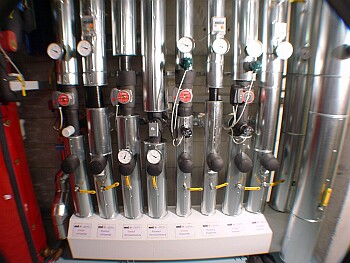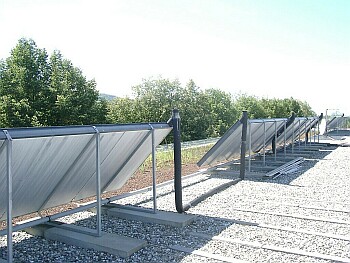de | en | fr | tr
Passive house »Wohnen & Arbeiten«
Walter-Gropius-Strasse 22 • D-79100 Freiburg • Germany • Vox: +49 761 4568330Email: post(at)passivhaus-vauban.de • Web: www.passivhaus-vauban.de
| The Idea | |
| What is a Passive house? | |
| Energy Concept | |
| Research Outcomes | |
| The Cost | |
| Co-generation Unit | |
| Architecture | |
| Residents, Owners | |
| Guided Tours | |
| Download | |
| Privacy policy | |
| Credits | |
The Energy Concept of "Passivhaus Wohnen & Arbeiten"
| Ventilation and Exhaust Gas (Glass tube) of the CHP | |
 |
|
| Click on the picture to enlarge:1024 x 768 | |
| Co-generation Unit | |
 |
|
| Heat Distribution | |
 |
|
| Solar Heat Collector | |
 |
|
| Solar Power Plant | |
 |
|
| Power Inverter | |
 |
The Passive house was already a subject of research before its construction. The DBU-funded Fraunhofer-Institute for Solar Energy Systems (Martin Ufheil, founder of solares bauen and of our House automation bureau, Krebser & Freyler in Teningen) has greatly supported us energetically during the planning period.
As one of the first steps, one must research about which theoretically feasible energy efficiency measures are actually practicable in such a house, for example, a solar panel or waste water heat recovery. With the isolation measures, the optimal measure has to be ascertained by analyzing each measure in terms of both the initial investment (then still in DM) and the cost of using (yearly financial saving).
In the second step, the cost/performance ratio of all the measures are calculated and sorted. thereby, one can know if insulation or combined heat and power unit (CHP) has a better cost/performance ratio. The cost/performance ratio is calculated by taking into account the ecological benefits aspects as well as the cost-saving ones. It is important to know how much money one needs to spend in order to cut down on a certain amount of CO2 .
Along with the recommendation of the Fraunhofer-Institute the assembly group decided to carry out all the measures whose cost/performance ratios are better than that of the photovoltatics (solar electricity). We bear in mind that solar electricity is renewable and ecologically very sensible, and also clearly more expensive in comparison to combined heating and heat insulation. By this way, the house was expected to reveal, how many other investings are feasable, which can "amortize better" than the solar electricity cells in the bush.
We have nothing against the solar electricity, often, the photovoltatic colectors are the only sensible option of an ecological investing on site. However, the old building reconstruction and the combined heat and power generation still have a much bigger potential.
Kasten: CO2-equivalentYou can learn more about the real energy concept from Download-page.